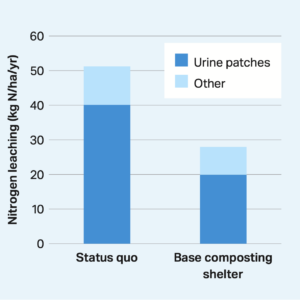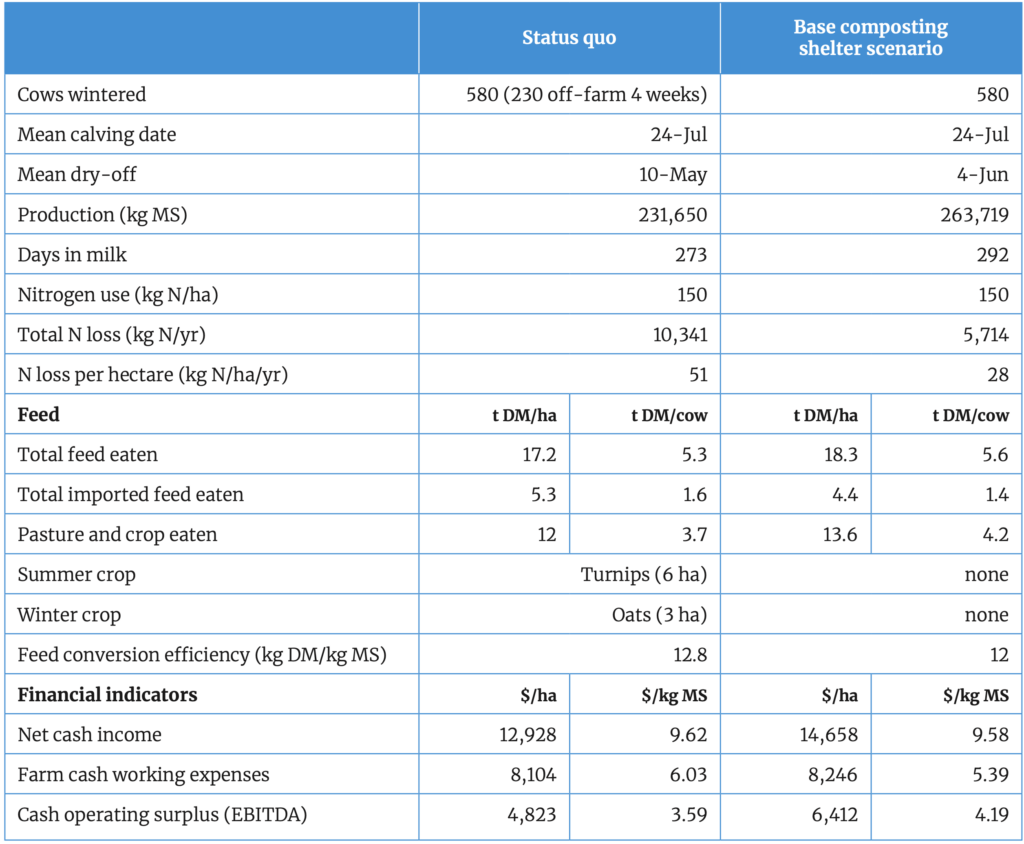Shelter from the Storm
Composting shelters offer shade from the summer sun, and keep cows and staff warm and dry in winter while reducing pasture damage and nitrate leaching. But how do they fit in with our pasture-based grazing systems?
Animal welfare concerns during winter were at the top of the list of reasons farmers chose to look at integrating composting shelters into their dairy farming operations.
Keeping their animals warm and dry, out of the cold and the mud and on a non-concreted floor had a lot of appeal for them, as did less stress on staff.
Avoiding damage to pasture from pugging during wet weather and improving pasture management were other reasons.
These were just some of the findings by Perrin Ag farm consultant Rachel Durie, after interviewing six dairy farmers who had recently integrated composting shelters into their farming operations.
Rachel led the project with technical support from Keith Woodford (AgriFood Systems). They researched how these structures are used and how successful they are, including from a financial perspective, for various farming operations – with funding through the Rural Professional Fund from the Our Land and Water National Science Challenge.
With at least 30 composting shelters up and running around the country already (and more being built), there is growing interest in them, particularly as environmental regulations increase. The structures are new to New Zealand – with the first one less than 10 years old. They are also a farmer-led initiative, with little formal research completed as yet to support farmers in managing them as they integrate them into our pasture-based systems, or for other interested farmers to follow.
The owner of a Canterbury-based operation has been using a composting shelter for the last couple of years and says concerns over the animal welfare side of winter cropping is behind him getting his animals off the land during winter.
Cropping in winter is common practice in Canterbury, Otago and Southland. “While the animals look good at the end of winter from good quality feed, the process is hard on them,” he says. “They’re out in the weather all the time, the rain, the mud and everything that goes with it.”
Added to this was the anxiety of sending animals off- farm for winter grazing with Mycoplasma bovis in the area. This led to him looking for an alternative system that would give better outcomes for the animals, while becoming largely self-sufficient and keeping all their animals on-farm.
“While we dropped stock numbers to do this, running costs have absolutely flattened out and profitability has risen. “It’s taken a lot of stress off the cow shed and the staff,” he says.
New winter cropping rules coming into effect from November won’t affect the operation, nor concerns over nitrate loading.
“We’re in a high nitrate area and need to get that loading down by 36% by 2035. This new wintering system gets us there now.”
Reducing heat and human stress
The interviews showed two different types of operation. One was a wintering-only system to replace cropping used for a farm in Canterbury and another in Southland. The animals were outside the rest of the year.
The other was a hybrid indoor-outdoor system where the animals are in the shelters for a portion of the day, most of the year round. The cows are usually brought inside at night during autumn and winter, and during the day in the hotter parts of the year.
One farm has automated gates so the cows can choose when they move into the shelter. This tends to be when the temperature rises to between 20° and 25°. Other farmers have temperature gauges that prompt them to collect their cows and bring them inside.
Heat stress is likely to become more of an issue as the climate warms, Rachel advises, along with more extreme weather events. Being able to move animals under cover is likely to become increasingly important.
Calving is one of the most stressful times of the year on dairy farms and can be pretty miserable for both staff and animals out in bad weather. Farmers found the shelters really shone during this time, with calves born into warm, dry conditions and staff also not stressed.
“One of the ways to take the stress out of the system for the staff is to take the stress out of the system for the animals,” one farmer commented.
Keeping the animals more comfortable, where they’re not using energy to keep warm or getting heat stressed, is also good for production, with more milk and a longer milking season possible.
Bedding is a key factor
The shelters have a high roof and no walls, although sails have sometimes been set up to stop excess rain getting onto the bedding. Some structures have a solid roof, while others have a material-covered tunnel roof.
Good airflow through these open structures, and turning the thick layer of dry bedding material (often wood chips or sawdust) that goes onto the shelter floor into compost, is at the heart of the system.
Current recommendations are for the bedding to be around 600–800 mm deep. Urine and dung are absorbed into the bedding and tilled. In a well- managed shelter there is no effluent to manage and no odour. Turning the material each day aerates it, providing a warm dry environment. At the end of its life, this compost can be spread out onto pasture, potentially reducing fertiliser costs.
There is still plenty to learn about getting the most out of the bedding, and this is an area where more research is needed, Rachel says.
Stocking rates of bedding material ranged from 5.5–9 m2 per cow, with this usually replaced every one to two years, and with one farmer aiming for three years.
An operation running 440 cows could see over 3,000 m3 of bedding needed to fill a shelter. With bedding the biggest expense after the structure itself, keeping it in good condition makes good financial sense.
With climate change mitigation measures ramping up, one farmer thinks this could put a lot of pressure on forestry waste for bedding in the future. With this in mind, he is looking at establishing a plantation of miscanthus. Growing up to 4 m high, this grass plant is being grown more often specifically for use as bedding. If they spread one-third of their compost each year they should be able to grow enough to replace it, he reckons.
With no guidebook, learning as you go is common among the farmers. One farmer learnt the hard way that bedding needs to be dry when it goes in the shelter after having to sort out pooling when his wet sawdust didn’t absorb as much waste.
Despite the high cost of getting the shelters erected, the farmers were pleased with their investment, with few if any negatives noted and none wanting to return to their previous system.

Modelling return on investment
The information gained from the farmers’ experiences was used to support modelling for different composting shelter scenarios on a case study farm (Table 1).
The farm was Kokako Tuarua in South Waikato, owned by Kokako Pi Karere LP, with the owners also keen to see how the composting scenarios performed in relation to their current system.
Environmental, physical and financial performance were the key areas looked at, taking impacts to animal welfare and staff wellbeing into consideration.
Two composting shelter design structures were modelled in the investment analysis. High and low capital cost versions with a solid roof ($2.6 million and $2.3 million), and high and low capital cost versions with a material tunnel roof ($1.9 million and $1.6 million), were modelled.
The extra costs in the high capital scenarios come from concrete infrastructure for compost retaining walls, cow standing areas for feeding and lanes for tractor access. These can be replaced with gravel and timber which, while cheaper, have additional ongoing repair and maintenance costs.
However, in many situations farmers were opting to minimise concrete in the builds due to cost, effluent management and animal health considerations, Rachel says.
The shelters were modelled to operate as a hybrid year-round indoor-outdoor grazing system. Financial analysis considered both a 25-year investment period and a 50-year investment period, recognising a longer- term Māori view which would also be the expected lifespan of the structure.

The whole business return for the case study farm was 6.3%. Depending on infrastructure decisions, the whole business return for the composting shelters ranged from 6.8% for the high-cost structure to 7.4% for the low-cost structure. The return on the actual investment itself over a 50-year period ranged from 8.4–12.4%.
Modelling suggested that at a $9/kg MS milk price, milk production on the case study farm needed to increase by 31–43 kg MS/cow, depending on capital costs, to get the same return as the base system. This was achieved in the modelled system with an additional 57 kg MS/cow projected due to increased pasture growth, improved feed conversion efficiency and the mitigation of heat stress.
Where operating costs can be significantly reduced, as would be the case where intensive winter cropping is replaced with in-shelter wintering, the extra production would be less.
Overall, the project found the economics of the composting shelter scenarios appeared sound.
From an environmental perspective, modelling in OverseerFM v6.4.3 found the shelters resulted in a 45% reduction in nitrogen leaching on the case study farm (see Figure 1). This was largely put down to reduced urine on pasture.
More research is needed to discern how the shelters perform in relation to greenhouse gas emissions. While reduced urinary nitrogen on pasture should lead to less overall nitrous oxide emissions, the impact of the in-shelter aerobic composting process on emissions is yet to be investigated. More research is needed to confirm this.
The composting scenario on the case study farm also fitted well in a te Taiao context, being good for land, animals and people.
Impact of composting shelters on dairy farm systems
Why: To compile knowledge from farmers using composting shelters about animal welfare, staff wellbeing, and the economic, environmental and operational impacts on a farm system.
Where: Six farms from Waikato to Southland with composting shelters in place, plus a Waikato Māori-owned case study farm.
Who: Rachel Durie (Perrin Ag Consultants), Keith Woodford (AgriFood Systems), Kokako Pi Karere LP and six composting shelter farmers.
What:
- Significant reduction in winter feed compared toa 24/7 outdoor system.
- Correctly maintained bedding material holds urine and dung in the shelters with no effluent capture needed.
- Improved cow welfare, body condition and feed utilisation can see more efficient and higher milk production, and an extended milking season.
- Significant reductions in nitrogen leaching possible – a 45% decrease to 28 kg N/ha/yr modelled on the case study farm.
- Amount of milk produced per kilogram of nitrogen lost doubled in the base composting shelter system, along with a 36% reduction in nitrogen surplus.
- Research required to determine impacts to greenhouse gas emissions.
Read more: Whole systems impact of composting shelters in New Zealand: Whole systems impact of composting shelters in New Zealand: Final report, August 2022
Author
 View Our Strategy Document 2019 – 2024
View Our Strategy Document 2019 – 2024




Leave a Reply